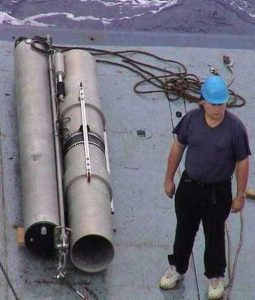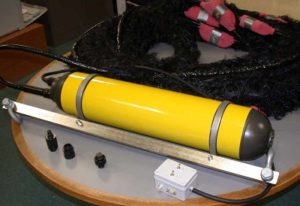A System for Acoustic Tomography and Global Ocean Monitoring
Collaborators: Andrey K. Morozov, Douglas C. Webb

Deep water low-frequency sound source in the SCRIPPS test pool.
Long-range, underwater acoustic systems, such as those used in ocean acoustic tomography, require low frequency signals covering a broad frequency band. To meet this requirement, a novel design based on a tunable, narrow-band, high-efficiency sound projector has been exploited.
The projector transmits a frequency sweep signal by mechanically tuning a resonator tube (or organ pipe) to match the frequency and phase of a reference signal. The resonator tube projector consists of a symmetrical, pressure balanced Tonpilz driver placed between two coaxially mounted tubes. The Tonpilz acoustical driver is composed of two pistons separated by preloaded ceramic stacks. The resonant tube is a simple, efficient, narrow-band, medium-output projector, which operates at any ocean depth. Both projector tubes have slots (or vents), which are progressively covered or uncovered by sliding coaxial tubular sleeves.
The frequency varies with the sleeves position. A computer controlled electro-mechanical actuator moves the cylindrical sleeves along the tubes, keeping the projector in resonance at the instantaneous frequency of a swept frequency signal. The actuator smoothly tunes the frequency of the resonator tube in the bandwidth of 200 Hz to 300 Hz during a 135 second transmission. A computer synthesizes the linear frequency modulated signal, compares the phase between transmitted and reference signals, and using a phase lock loop (PLL) system, keeping the resonator tube frequency in resonance with the driver frequency. The estimated PLL precision is better than 3 degrees phase error. The system was analyzed by means of finite element analysis and electrical equivalent circuit simulation. The projector prototype was first tested at the Woods Hole Oceanographic Institution (WHOI) dock in Woods Hole, MA, and later in the Pacific Ocean during a voyage of the R/V “Point Sur.”
- Sound source test in the Atlantic Ocean.
- STAR-mini
STAR-mini receiver
The STAR-mini, a multi-channel 16-bit data acquisition (DAQ) system for at-sea, acoustic data collection, was designed for deep and shallow water acoustic measurements. The DAQ system collects data from an 8-channel, current-mode hydrophone array and records continuously at a 8kHz sample rate for a period of 20 days onto a hard disc or internal CompactFlash memory card. The receiver can be programmed through RS-232. The receiver has an internal TCXO or CSAC clock synchronization with GPS receiver.
Funding Agency


